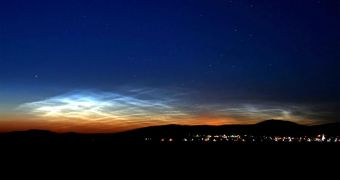Breaking images taken by a new NASA satellite shows extremely detailed images of a mysterious kind of clouds appearing over the Arctic region and moving towards Northern Europe. These clouds shine in the night sky and are moving out of the polar regions and scientists can't explain why.
They are called "noctilucent clouds" which literally means "night-shining" in Latin, and were first observed in 1885, two years after the Krakatoa eruption. But most volcanic eruptions do not spew material high enough in the atmosphere to seed the formation of the icy clouds.
Forming at the edge of space, they appear to be getting brighter and more frequent, raising questions as to their possible link to global warming. It's not only this increase in brightness that puzzles scientists, it's also the fact that they used to be spotted at high latitudes, but in recent years, the evening clouds have been spotted as far south as Utah, in the US.
This is the first time the "Aeronomy of Ice in the Mesosphere" (AIM) satellite saw these strange cloud formations and even people on the ground started seeing them on June 6, over Northern Europe.
Their place of origin is thought to be the upper layer of the atmosphere called the mesosphere, from about 50 km to 80-90 km altitude above Earth's surface. Made of water vapor and ice crystals, they usually appear in summer above the North Pole and also in the South Pole summer.
AIM satellite will document the clouds over both regions, for the first time, to help researchers understand why these noctilucent clouds form and how they could be indicating climate changes around the planet.
"It is clear that these clouds are changing, a sign that a part of our atmosphere is changing and we do not understand how, why or what it means," said James Russell III of Hampton University in Hampton, Virginia, an atmospheric scientist. "These observations suggest a connection with global change in the lower atmosphere and could represent an early warning that our Earth environment is being changed."

 14 DAY TRIAL //
14 DAY TRIAL //